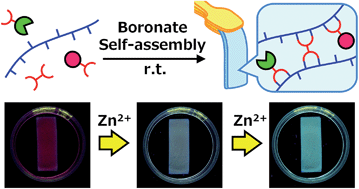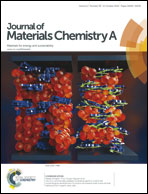A boronate hydrogel film containing organized two-component dyes as a multicolor fluorescent sensor for heavy metal ions in water†
Abstract
A multicolor fluorescent hydrogel sensor containing two types of fluorescent dyes with an amidoquinoline receptor unit and a rhodamine chromophore covalently incorporated into a polyvinyl alcohol–boronate matrix was prepared. Although the gel film exhibited red emission due to the rhodamine chromophore, the addition of a small amount of Zn2+ ions induced a multicolor fluorescence response, which included white-light emission, of the film in water. The change in emission color is ascribed to fluorescence enhancement of the amidoquinoline moiety upon binding to Zn2+ ions with an association constant of (3.5 ± 0.2) × 105 M−1. In contrast, a negligible change in the emission color of the gel film was observed in the presence of Na+, K+, Mg2+, Ca2+, Fe3+, Co2+, Ni2+, Cu2+, Cd2+, Hg2+, Al3+, and Pb2+ ions. The selectivity of the gel film enabled visual detection of Zn2+ ions in tap water. Moreover, the film could be reused as a sensor strip after treatment with ethylenediaminetetraacetic acid.

- This article is part of the themed collection: In celebration of Seiji Shinkai's 70th Birthday

 Please wait while we load your content...
Please wait while we load your content...